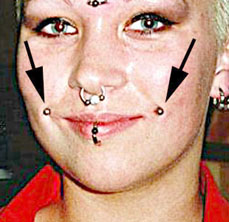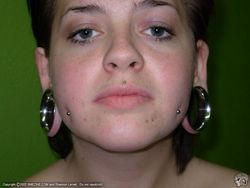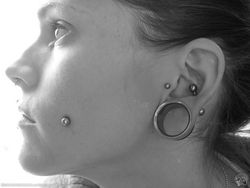Cheek Piercing
Jump to navigation
Jump to search
Cheek piercings are usually done using long labret studs, placed through the "sweet spot" in the cheek — usually right where a dimple falls. Other placements are perfectly possible, though blood vessels are far more likely to become a problem, still, it is certainly not unheard of for an individual to have a row of cheek piercings (although the dimple location is by far the most common).
To find the "correct" placement for a cheek piercing, you can insert your finger in your mouth like a hook being dragged across the cheek. The place at which it wants to settle is your "sweet spot" and will heal more easily than other placements.
Don't place it behind the first molar to avoid interferences with the parotid gland.
Alternative Names
- Dimple Piercing


